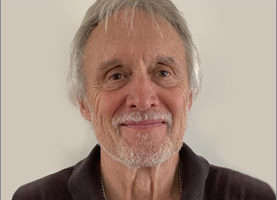
Support Us
Donations will be tax deductible
Andrew Thompson is a Professor of Parasitology at Murdoch University who joins the show to discuss the ins and outs of his research on parasites.
In this episode, you will learn:
Thompson’s work on parasitic diseases began many years ago, when taking a class on invertebrate zoology. One project in particular struck his interest: the role of the dwarf tapeworm in mice. Since then, his research has gone far beyond tapeworms.
In recent years, the focus has been on parasites of wildlife—particularly those that may have conservation effects. In other words, parasites that normally don’t cause much of a problem without the impact of human involvement and man-made domestic cycles.
He gives a number of fascinating examples, and discusses the studies which led to these findings. He discusses the progression of hydatid disease in humans and domestic animals, surgical removal as an intervention, what can be done to prevent it, and much more.
http://www.murdoch.edu.au/Research-capabilities/Research-stories/Andrew-Thompson/
Available on Apple Podcasts: apple.co/2Os0myK
Richard Jacobs: Hello, this is Richard Jacobs with the Finding Genius Podcast. Andrew Thompson is a professor of Parasitology at Murdoch University, Australia. He’s gotten up at an ungodly hour to do this interview, so I appreciate that very much. Andrew, thanks for coming.
Andrew Thompson: My pleasure.
Richard Jacobs: Tell me about what’s spread your interest in parasites long time ago whenever you started working with them?
Andrew Thompson: It was a long time ago. Well, basically my training initially was as a zoologist and it came down to basically my teachers and a teacher in vertebrate zoology came up with a list of projects that we had to do for our honors in our final year and there was one project that particularly got my attention and interest, which concerned studying tapeworm, that’s very tiny little tapeworm in mice and had a two-hosts lifecycle, the other part of a lifecycle is a tiny little beetle and its common name is the dwarf tapeworm or Hymenolepis nana to give it its grand name. And yes, I did a project on this tapeworm living in mice and learned more about his natural history and I’ve never looked back.
Richard Jacobs: So, what’s the tapeworm of the month for you, which one you’re looking at right now?
Andrew Thompson: That was a long time ago, I’ve moved on from that particular parasite. Now, over the years, I’ve worked on a large number of parasites, not just tapeworms, scientifically there are [inaudible – 0:01:37.1] but also single sold parasites, things like Giardia that you may well have heard of or even have been infected with but mainly I supposed the common …
Richard Jacobs: That comes from water sources, right?
Andrew Thompson: It can be and particularly in North America, that’s where it’s got a particularly bad reputation. But I suppose the common theme has been and is parasites that can be shared between humans and other animals. And the term for those parasites is zoonosis and that name means there can be a transmission between the two.
Richard Jacobs: So, just like viruses can be zoonotic and these parasites can be too, right?
Andrew Thompson: Absolutely. It’s just that there’s a separate discipline for viruses, virology; for bacteria, bacteriology, and then there is this huge group of organisms from single-cell things like malaria all the way through to multicellular organisms like tapeworms and so on that come under the umbrella of parasitology.
Richard Jacobs: As you were talking, I imagine you have a calendar on the wall with the parasite of the month. I wonder if anyone would like that as a gift each month, there’s a big picture of a new parasite and a brief description of it. I guess only parasitologists probably [inaudible – 0:03:00.6].
Andrew Thompson: Yes, probably. I suppose nowadays with the great sort of imaging technics that we have, you do get some amazing pictures of parasites and some of them could look really awesome and quite cute sometimes, depending on which one you’re looking at.
Richard Jacobs: So, what’s your current focus? Which parasite are you working on right now?
Andrew Thompson: I suppose in recent years, we’ve been concentrating on parasites of wildlife, particularly those that may have conservation effects, i.e. may affect the health of wildlife, and again, parasites that normally don’t really call as much of a problem in wildlife but as in many cases, human involvement, either by affecting the environment or creating conditions where parasites can spread or introducing new parasites to which wildlife is susceptible, those things have been interesting us to a great degree.
Richard Jacobs: What kind of parasites and which wildlife may interest your mind?
Andrew Thompson: I’ll give you a few examples. I don’t know whether you’ve heard of hydatid disease.
Richard Jacobs: No, I haven’t.
Andrew Thompson: It occurs in North America and throughout the world. It’s a cystic infection. Again, in the adult stage, it’s a small tapeworm and the larval stage is a cyst that manifests itself large cyst up to the size of tennis balls or even bigger in the internal organisms of the host. And it’s two-host lifecycle, [inaudible – 0:04:39.3] carnivores that harbor the small adult tapeworm and then a whole variety of omnivorous or herbivorous animals that can harbor the cystic stage. And basically, in order for the cycle to continue, the carnivore has to eat the cystic stage. So you can imagine a natural cycle as you have in North America between wolves and moose, for example, moose with the cyst moves the predator eating the cyst in the moose. And that’s probably the best-known natural cycle that occurs in the wild. But because of men’s involvement in various parts of the world, the parasite has become “domesticated”. So it’s very common where you have livestock such as sheep and dogs, dogs eating the cyst from the sheep usually because of human involvement, humans doing slaughtering the sheep, farmers, for example, maybe slaughtering a few sheep at home for their own use and the dogs get into the offal from the slaughtered sheep and the lifecycle is completed. And that’s the most common way throughout the world. Middle East, Europe, North America, it’s a men-made domestic cycle but it also can get into wildlife. I mentioned the natural cycle between wolves and moose or other large deer but in Australia, for example, hydatid disease never existed in Australia before settlors arrived and they brought their sheep and their dogs and they started a cycle between sheep and dogs and the dogs infected with the tapeworm contaminated the environment, which was shared by other grazing animals like kangaroos and wallabies and they became infected with this hydatid parasite.
So they were completely naïve hosts, the parasite in the wallabies affects the lungs and grows to be sometimes quite big, effects the exercise performance of the wallabies and the kangaroos, so they become easier prey to animals like Dingos. So humans, unwittingly, in the early days of settlement, established this what had become a domestic cycle into a novel wildlife cycle in the Australian environment. And now, Australia cannot eradicate hydatid disease because in order to eradicate it, we’ll have to shoot all the Dingos and all the Macropod marsupials. So, that’s a really good example of a parasite in wildlife that was introduced by humans. I have many more.
Richard Jacobs: So, where is your focus for them, the parasite world, are you trying to figure out how to stop them or simply to understand them and the modern complexity of their behavior?
Andrew Thompson: I mean the end-goal is to control it in some way but initially you have to understand it so the initial studies with that — when we found the cysts in kangaroos and wallabies, for example, we had to try and determine was this here before settlement, has it always been in Australia? So, to compare the parasites, either ones in the macropod marsupials, and the ones in sheep. Initially, you do that under the microscope, they look the same but then, with the advent of molecular tools, you can compare the DNA and we determined along with other colleagues that the parasites were identical. So, it was the same as the ones that had been introduced into Australia in sheep. So, we knew we were dealing with a parasite that we could control in sheep and dogs by legislation, telling farmers that they shouldn’t feed their sheep dogs on home-killed sheep but you can’t do that with a wildlife cycle. And so we basically, in Australia, now have a cycle that we understand. It does harm to the wildlife if people hunt kangaroos and then feel the offal to their dogs, then they could start a cycle in their own domestic dogs. So, it’s a question of education but it could never be eradicated.
Richard Jacobs: What happens if you cook the kangaroo meat or the organ meat? If you really want to feed it to your animals, what if you cook it? Will that solve the problem and break-open the cyst?
Andrew Thompson: That would solve the problem certainly with the sheep-dog cycle. Farmers are encouraged, 1) not to do it, but 2) if they do do it or dogs accidentally get into a [inaudible – 0:09:24.5] carcass of dead sheep [inaudible], then that meat that they harvest has to be cooked but really the bottom-line message is don’t do it.
Richard Jacobs: Why say don’t do it when cooking would solve it? What would a farmer do with that waste then, just throw it and then, if you’re going to store it, wild animals would smell and love to get into it? So, I think that would cause wild animals to approach your encampment and if you just get rid of it, why waste it? It seems like that’s a bad idea; it’s better to cook it.
Andrew Thompson: Right, okay. Well, it’s getting into a controversial area now. In Australia, for example, in New Zealand and many other countries that raise sheep, Middle East, for example, it’s been shown over many years that the only way to control this hydatid disease in domestic cycles like that is by education, 1) do not feed your dogs on offal because you can cook it but people don’t cook it thoroughly and if the parasite still gets through? So, the education campaigns that have worked have been education, and then if they don’t do it, you have legislation. And in Australia, the endpoint was that farmers who were found to have infected sheep, if they didn’t obey the rules then their farms were quarantined and they weren’t allowed to sell their sheep. So, it became a domestic issue. There were some cases in Australia in the early days of the hydatid control campaigns where farmers were even jailed because they wouldn’t comply.
Richard Jacobs: What do people do with the offal if they don’t cook it and they’re supposed to get rid of it? Where it can go where it wouldn’t be a harm?
Andrew Thompson: Basically, they’re advised not to home-kill but it can be buried or it can be theoretically boiled. When I was doing my Ph.D. when I did my initial education in England and I did a Ph.D. on hydatid disease in horses in the United Kingdom. And there, they had a cycle – they still have but it’s not as frequent as it used to be – involving foxhounds and horses. It was an artificial man-made cycle involving recreational pursuit to fox hunting. And I went around to some of the foxhounds where they used to feed horsemeat back to the dogs. And all these hunts had huge boilers where after slaughtering the horses, they were supposed to boil the meat so that any infections, not just hydatid but other diseases, could be spread to their foxhunts and I used to go to these places, it was an interesting way to start one’s Ph.D. These hunts, many of them in these days, had huge great big boilers and you’d see these bits of carcasses sticking out of the boilers and there was no way on earth that those boilers were functioning correctly, heating the meat up. And so we found hydatid disease of the tapeworms to be prevalent in the foxhounds that we looked at.
Richard Jacobs: So, which host would be the easiest one to try to intervene and get rid of these parasites or stop the tapeworms? What do they call, the definitive host I guess is the — that would be the dog, the meat of the offal and they enter median host is where it comes from?
Andrew Thompson: Yes, exactly. I mean basically, the message in not just hydatid disease but most of these zoonotic-type cycles is break the cycle. So number 1, do the right thing, and don’t let the infection get into your dogs but it can be backed up also with giving drugs to the dogs. There are very, very safe and effective drugs that you can get to dogs to kill the tapeworms now. So, there is a two-pronged approach.
Richard Jacobs: Is there something you can add to the food so that if a dog does eat offal and it’s contaminated that it won’t make it sick?
Andrew Thompson: Not really. If you think that the dog may have been exposed, then you can prophylactically will give the dog these habits. They work very well.
Richard Jacobs: So, there’s nothing you can add to the meal to make it literally edible where a dog could eat contaminated offal and they wouldn’t get sick?
Andrew Thompson: Only if it’s cooked; only if it’s thoroughly cooked. But what I’ve been talking about there is the domestic cycle but we can’t do anything to prevent Dingos becoming infected from wallabies that they may have predated. So, we have his artificial cycle in Dingos and wallabies, which contaminates the posture that a sheep may share. So, it feeds over to the domestic cycle, fascinating.
Richard Jacobs: I mean in studying the lifecycles of these tapeworms, what does come to mind as an intervention, what can be done?
Andrew Thompson: A vaccine is another possibility and colleagues of mine at the University of Melbourne have developed an extremely effective vaccine that can be used to vaccinate sheep, for example, so that they don’t get hydatid disease.
Richard Jacobs: So, where does tapeworm reside when it goes into dogs and other creatures and people, just in the gut or where does it go?
Andrew Thompson: In the dogs, a small tapeworm lives in the gut, doesn’t cause the dogs any harm whatsoever. In the hosts, the intermediate hosts like kangaroo, sheep, humans, the cyst develops in the livers, lungs, and occasionally other organs, even the brain. So it can be extremely serious in other animals. In humans, it’s probably most pathogenic and usually, in humans, surgery is required.
Richard Jacobs: To remove the tapeworm, what kind of surgery?
Andrew Thompson: Well, the surgery that would expose the liver or the lungs so that the surgeon can aspirate the contents of the cyst and then remove the cyst by basically cutting it out to the liver or lungs. I mean it’s a pretty, pretty severe disease in people. And there are various forms of the parasite and I haven’t got time to go into all of them but there’s another one that’s more common in Central Europe that many people, many medics regard it incurable and that’s just caught pretty early. So, that’s a good example of a parasite that we basically have caused the spillover to wildlife.
Richard Jacobs: So, what can be learned from the tapeworm’s invasion of our immune system or above the creature’s immune systems? I’m sure it’s being studied in many ways, I mean what can be learned from it and maybe repurposed and used for other medicine?
Andrew Thompson: That’s a big question. I mean you can’t generalize and say what we learn with respect to hydatid disease can be applied to other parasites, it can’t. What we’ve learned with hydatid disease is that immunity is generated in the early stages of infection in the intermediate hosts like humans and sheep but very quickly, the parasite develops its cyst which walls it off from the host’s immune system. So it basically sits there and does its own things, sitting in the cyst and the antibodies – and we know there are protective antibodies – can get rid of the parasite because it’s within a cyst. So, the parasite has this extremely effective defense mechanism.
Richard Jacobs: But this cyst would have to allow the — I mean is it totally dormant in the cyst stage or you would have to allow the passage of minerals and food etc.?
Andrew Thompson: Oh yes. But the cyst is an extremely complicated multi-layered structure and the parasite allows certain things into the cyst, presumably cyst materials, nutrients, and so on but antibodies can’t get in there. One thing that surgeons can do prior to removing a cyst, the cyst is a bit like cancer that if you leave a little bit behind, the parasite will regrow again. This is in surgery. And what surgeons can do before removing the cyst is to inject into the cyst some of the person’s serum knowing that that serum will contain antibodies that can kill the parasite before they try and remove the cyst. So, there are antibodies being generated but as with many parasites, from tapeworms throughout to malaria, the parasites have evolved and developed mechanisms to help them survive in their hoses.
Richard Jacobs: So, if you remove part of a cyst, it’s been determined that the remaining part will regrow back into a complete cyst?
Andrew Thompson: Yes, exactly. So, in the early days in Tasmania – I’m going back to when they have the sheep-dog cycle – they were educating people about the dangers of the parasite. And the most effective pictures that came out on the educational leaflets were of little kids that have become infected and just showing the scars on their chest and abdomen and back where the surgeons had to cut in to get rid of the cysts. And those sorts of shocking photos really helped to get the message across.
Richard Jacobs: It seems perhaps the abilities of the parasite can be harnessed for other medicines, so I know it would be interesting to study them to see how they do what they do, it’s pretty amazing.
Andrew Thompson: Yes. And there are many, many parasitologists doing that throughout the world at the moment with various parasites.
Richard Jacobs: What is the particular role that you are engaged and how do you want to make an impact?
Andrew Thompson: My role has been, I suppose, to infuse people and probably the greatest joy that I’ve had throughout my career as a professor has been a mentor and supervisor of research students. And so infusing other people, young people about parasites and the ways in which we can study them has been the most enjoyable part of my career, I think.
Richard Jacobs: Are there any up and coming treatments for various parasites that you think really show a lot of promise or are there any breakthroughs in understanding, for instance, you said a partial cyst can revert and will become a full one?
Andrew Thompson: No, not really. I’ve just, with some colleagues, edited a large volume on hydatid disease and it’s a huge chapter in there on the clinical aspects with myriad ways of operating that have been developed and of diagnosing using CAT scans and various other radiological technics to try and diagnose infections early. As I said, the vaccine has been developed but there, the big thing is getting enough money to allow the vaccine to be distributed and used in areas of the world where the parasite is most common, particularly in developing countries and it’s old, old problem there of not having pharmaceutical companies interested in promoting the vaccine because they’re not going to make enough money from using the vaccine in developing countries like Africa and the Middle East.
Richard Jacobs: Very good. What’s the best way for people to find out more about your work and about your students and everything, where can they go?
Andrew Thompson: Well, there’s a website and I think you’ve already got that website and you’d referred to it in some of the emails I’ve got earlier. But basically, yes, going to my university, Murdoch University, and searching myself and my other colleagues in parasitology. And of course, the main way in which we get our message out is by publishing, so I published a fair few papers and books people can read and are available.
Richard Jacobs: What’s the name of some of the books that people can check out if they like?
Andrew Thompson: Well, perhaps the most recent one is the Biology of a Cyancoccus and Hydatid Disease. It was the most recent volumes that I mentioned published by academic press and advances in parapsychology.
Richard Jacobs: Okay, very good. Andrew, thank you for coming. And again, I really appreciate the fact that you got up at an odd time to do this. So, thank you so much.
Andrew Thompson: Fine, my pleasure. Nice to meet you.
(End of recording)
Podcast: Play in new window | Download | Embed

In this episode, we connect with Annie Chen, an author, therapist, consultant, and coach who uses neuroscience research to help clients navigate the complexities of relationships and emotional… Read More

In this episode, we sit down with Marc Brettler and Amy-Jill “AJ” Levine to discuss the Jewish faith, Rabbinic Literature, the New Testament, Christianity, Anti-Semitism, and more. How… Read More

As businesses emerge from tax season, many ask: How can I maximize profits and minimize taxes for next year? John Scott, an Anders CPAs + Advisors partner, sits… Read More

In this episode, Avi Kumar, the Founder and CEO of KUWARE Inc., joins us to discuss business marketing, growth, and advertising. KUWARE is a marketing and advertising agency… Read More

Something had been brewing for years in the heart of the Nightingale household: a fervent desire to chart a course away from reliance on conventional systems and embrace… Read More







Subscribe to Our Newsletter
Get The Latest Finding Genius Podcast News Delivered To Your Inbox